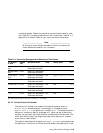
The disks are not reachable and you cannot boot until after the
system is initialized.
If you have not set the UDID, you cannot set the device unit
number as shown in Example 6–5. You have to use the
quickset
command with the item number displayed by the wwidmgr
-show wwid command (see Example 6–4). For instance, to set
the device unit number of item number 17 of Example 6–4to
770, use the following command:
P00>>> wwidmgr -quickset -item 17 -unit 770
The device names have also been set for the Tru64 UNIX disk and first
cluster member system boot disks. Record these device names for for later
use.
In the reachability portion of the display, the storagesets are reachable from
KGPSA pga through two HSG80 ports and from KGPSA pgb through two
HSG80 ports. Also, the device unit number has been set for each KGPSA to
HSG80 controller port connection, even if the storage unit is not currently
reachable via that connection.
6.6.1.4 Displaying the Available Boot Devices
The only Fibre Channel devices displayed by the console show dev
command are those devices that have been assigned to a wwidn environment
variable with the wwidmgr -quickset command.
The devices shown in the reachability display of Example 6–5 are available
for booting and the setting of the bootdef_dev console environment
variable during normal console mode.
If you were to execute the show wwid* console command now, it would
show that the environment variable wwidn is set for two disks. Also, the
show n* command shows that the units are accessible through four HSG80
N_Ports as follows:
P00>>> show wwid*
wwid0 133 1 WWID:01000010:6000-1fe1-0000-0d60-0009-8080-0434-002e
wwid1 131 1 WWID:01000010:6000-1fe1-0000-0d60-0009-8080-0434-002f
wwid2
wwid3
P00>>> show n*
N1 50001fe100000d64
N2 50001fe100000d62
N3 50001fe100000d63
N4 50001fe100000d61
Example 6–6 provides sample device names as displayed by the show dev
command after using the wwidmgr -quickset command to set the device
unit numbers.
6–48 Using Fibre Channel Storage


















